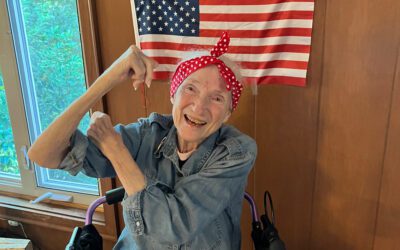[title subtitle="words: Marla Cantrell images:courtesy Riverview Hope Campus"][/title]
On any given night in Fort Smith, Arkansas, as many as 100 of our neighbors won’t have a bed to call their own. They sleep on the streets, behind dumpsters, in tents that do little to protect them from the extremes of Mother Nature. Their dreams are likely for things we take for granted—a car that waits in the driveway, a TV that jumps to life when we push a button, a refrigerator that puffs cold air across an ample supply of food.
In modest motels that rent by the week, more of our neighbors stay, spending much of what they earn for the privilege of a roof above their heads. When they look to the future, they probably see more of the same: enough money for their small room but no hope for anything better.
Chris Joannides, the executive director of Riverview Hope Campus, a project of the Old Fort Homeless Coalition, recently described the crush of poverty, the blight of homelessness. He sat at his desk, his fingers steepled, elbows resting on the desk top. On the opposite wall, a marker board as big as a window was filled with ideas, and with names of organizations that might help when the campus at 301 South E Street opens in October. The 40,000-square foot facility, designed by Architecture Plus, is housed in an old factory renovated for this purpose.
At the time of this interview, Chris, who’s from Cheyenne, Wyoming, had been in Arkansas only three weeks. His work with the homeless and underserved began there six years ago, and when he talked about the lives that organization touched, his face brightened. As much as those successes mean to him, his focus is now Fort Smith, and to the coming winter that will threaten those living on the streets. He said, simply, “This year will be different.”
Those five words encompass the hope that is swelling in our community. “I think of the campus as a one-stop shop: employment, education, housing, and health. For example, the Fort Smith Adult Education Center will be holding classes here. The Fort Smith Housing Authority will come by a few days a week to help our clients fill out applications for housing,” Chris said.
The dining hall that holds approximately 200 will serve three meals a day to anyone who’s hungry. There will be showers, a dormitory for those eighteen and older, with seventy-five beds, a library/study area, lockers where residents can keep their belongings, a place to get a haircut from stylists who will volunteer, a meeting hall for things like church services, even kennels for residents who have dogs.
Already, a local dentist has donated a dentist’s chair, and Chris is busy signing up volunteers in that field to provide basic services. The same is true for mental health care, with Western Arkansas Guidance and Counseling Center offering certain services.
And as of August 1, the new Mercy Clinic–Hope Campus is open on site, and will serve those utilizing the campus, as well as the general public. The clinic accepts most insurance, Medicare, Medicaid, cash payments, and will also offer financial assistance in several forms, including payment plans.
 When someone seeks help at Hope Campus, they’ll be asked to fill out paperwork and meet with a caseworker, who will learn their history and come up with a personalized plan to address their needs. The resident will then get settled in, assigned a bed and a locker. As long as they’re progressing, which could mean working on crafting a résumé, for example, they’ll be allowed to stay. “My experience is that folks are usually back up and running at between ninety and 120 days. Think about the person who’d been renting a hotel room by the week. They come here, and now all the money they’re earning is going to a savings account. In three or four months, now they have money for rent and deposits for utilities. When they leave here, their basic needs have been taken care of for a while so they can concentrate on the future. We’re not giving anyone a handout, we’re giving them a hand up. I’d also like to create work for those at the campus. For example, if there’s graffiti that needs to be removed around town, some of our residents could do that, and it would be cost effective for whoever needs it done. Trash needs to be picked up. There are different ways for the community to come together to make this work.”
When someone seeks help at Hope Campus, they’ll be asked to fill out paperwork and meet with a caseworker, who will learn their history and come up with a personalized plan to address their needs. The resident will then get settled in, assigned a bed and a locker. As long as they’re progressing, which could mean working on crafting a résumé, for example, they’ll be allowed to stay. “My experience is that folks are usually back up and running at between ninety and 120 days. Think about the person who’d been renting a hotel room by the week. They come here, and now all the money they’re earning is going to a savings account. In three or four months, now they have money for rent and deposits for utilities. When they leave here, their basic needs have been taken care of for a while so they can concentrate on the future. We’re not giving anyone a handout, we’re giving them a hand up. I’d also like to create work for those at the campus. For example, if there’s graffiti that needs to be removed around town, some of our residents could do that, and it would be cost effective for whoever needs it done. Trash needs to be picked up. There are different ways for the community to come together to make this work.”
“We know that some of the problems are addiction or mental illness,” Chris said. “For instance, you might need medication for a mental condition, but since you lost your job, you can’t afford to get your prescriptions, and you spiral down. Becoming homeless could happen to you or me. Most of us are about two paychecks from being in serious financial trouble. Bad timing, bad luck, losing your job, it can happen. And eighty-five percent of the people we’ll be serving grew up here. You went to school with them, or worked with them at some point.”
Putting all this together seems a lot like scooping up sand a handful at a time, trying to pour it into a bottle with a small neck. Chris said it’s more like compartmentalizing, taking on one task at a time. Like lining up volunteers, such as finding people to cook and serve meals. The ingredients will be provided—the River Valley Regional Food Bank has stepped in to help—but there will be a need for groups, churches, and families to volunteer to cook from the provided recipes.
Donations are needed as well. Surprisingly, a critical need is duct tape. When residents arrive, the tape is put on their bag, their name written in permanent marker. Then, they can leave the bags in their locker while going out to look for work, or going to work if they have a job already. As for how they’ll get from place to place, Chris says Champ Hinton Enterprises has donated a van. Toilet paper is another big need, as are socks, underwear, T-shirts, bottled water, and monetary donations.
This month, Chris is hitting the streets, spreading the good news to the homeless community. “I love these people,” he said, and then told a story about a man named Ken, who’d been homeless two years before he came to the shelter in Cheyenne. After staying there, attending AA meetings, he became the shelter’s receptionist and eventually moved to a home of his own. The talk turned again to addiction, and Chris said, “I know more than I want about addiction.”
Chris’ personal account begins years ago when drugs and alcohol ruled his life. “I worked hard, and I played hard. I had a brain that said more, more, more,” he said. Ten years ago, he got clean. For twenty years, he’d been in the new car business with his dad, and they had approximately 100 employees. The plan was for him to take over when his dad retired. But going through his battle made Chris question his purpose. He told his father that he felt a calling to help those who faced similar challenges, and he told Chris, “Go live your dream.”
While getting his master’s degree in social work, Chris interned at the shelter in Cheyenne, a position that transitioned to a full-time job. “I fell in love with the homeless. When you see someone have hope again, it’s the best thing ever.” As he said this, his phone rang. Someone on the other end of the line was looking for a little hope. Turns out, they’d called the right person.
To donate or volunteer at Riverview Hope Campus, or to learn more about their services, visit riverviewhopecampus.org.
Local Statistics (provided by Riverview Hope Campus)
• In January 2017, 168 people, 37 of whom were veterans, were homeless in Fort Smith.
• Of that number, 88 were not sheltered.
• 26.9% of Fort Smith residents earn an income that is below the poverty level. The national average is 14.7%.




